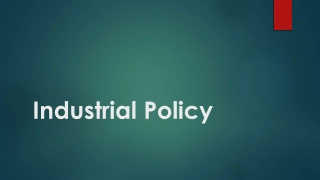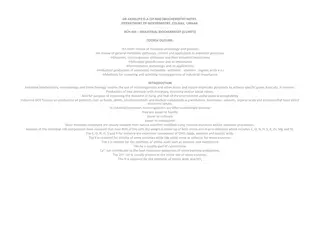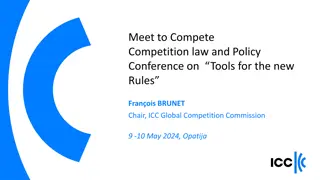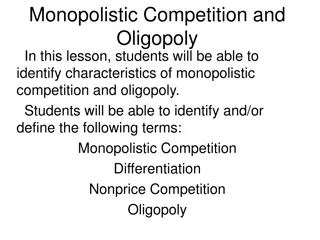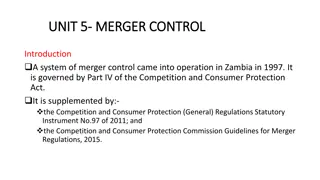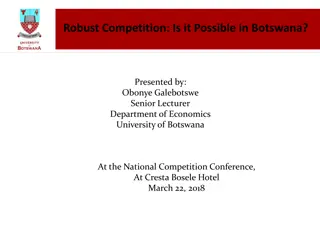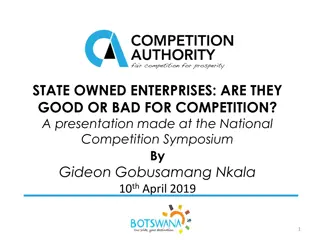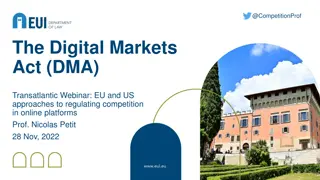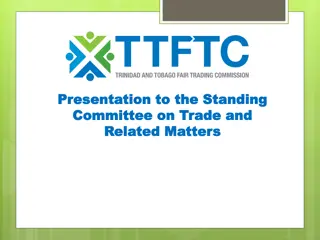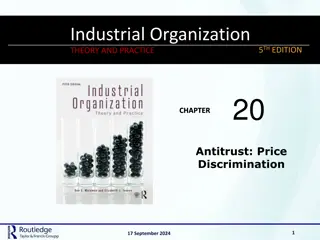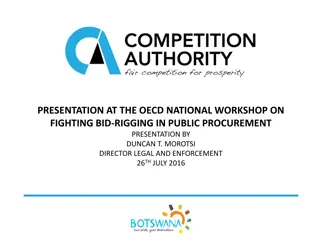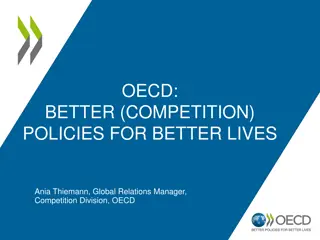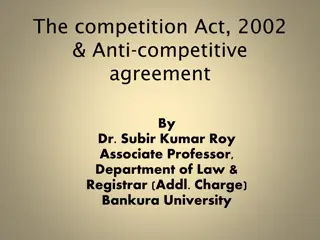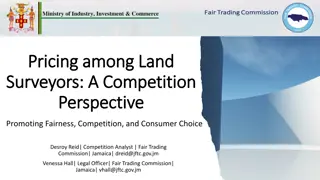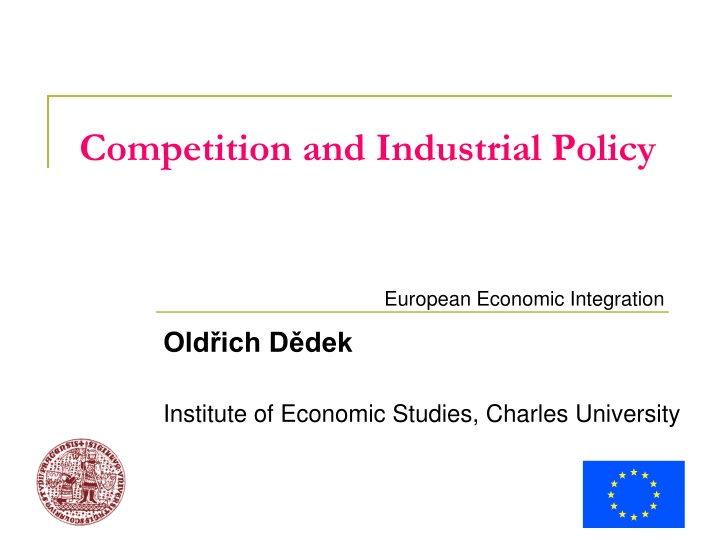
European Economic Integration: Competition and Industrial Policy Insights
Explore the significance of competition and industrial policy in European economic integration, focusing on the importance of competition, market failures, monopolistic and oligopolistic equilibriums, and strategic behaviors in market competition.
Download Presentation

Please find below an Image/Link to download the presentation.
The content on the website is provided AS IS for your information and personal use only. It may not be sold, licensed, or shared on other websites without obtaining consent from the author. If you encounter any issues during the download, it is possible that the publisher has removed the file from their server.
You are allowed to download the files provided on this website for personal or commercial use, subject to the condition that they are used lawfully. All files are the property of their respective owners.
The content on the website is provided AS IS for your information and personal use only. It may not be sold, licensed, or shared on other websites without obtaining consent from the author.
E N D
Presentation Transcript
Competition and Industrial Policy European Economic Integration Old ich D dek Institute of Economic Studies, Charles University
Competition needs protection Importance of competition Rivalry among firms acts as an engine of innovation activity Quality of price mechanism (precondition for allocation efficiency) Benefits for consumers (lower prices, wider choice) Important non-economic functions of healthy competition Market and government failures MF: Self-interest of producers in limiting competition (innovation process is costly and uncertain, threat of exit, etc.); time-consuming and uncertain outcomes of market solutions based on product innovations GF: Bureaucratic regulation stifles healthy competition; hidden support for national producers Competition policy aims at preventing distortions caused by private firms or by governments Permanent debate about the content and forms of regulation Illegal status of formerly legal private agreements (cartels) Ban on many previously quite common forms of government assistance (interventionist industrial policies) 2
Monopolistic equilibrium MC PC P PC PM D MRM MCM=MCPC PPC QPC QM Q PC Economic inefficiency of monopoly (QM,PM): marginal cost < price (utility derived from additional unit of production is higher than cost of producing this unit) Economic efficiency of perfect competition (QPC,PPC): marginal cost = price Other things equal goods on monopolistic markets are sold at a higher price and in a lower quantity Dynamic economic inefficiency of perfect competition (Q PC,P PC): higher marginal costs due to lower efficiency of large number of small producers 3
Oligopolistic equilibrium D total market demand DO residual demand PO market price QO... output of one producer QE output of all producers PM D PO=PE M O DO MRO MCO QO QM QE A higher number of competing producers pushes price down, increases total sales and lowers price mark-up (= measure of degree of monopoly) Strategic equilibrium in oligopolistic market (QO,PO) requires that expectations of all oligopolists about behaviour of their competitors correspond to actual behaviour (Cournot-Nash equilibrium) Expected residual demand QE QOmust be equal to actual supply of remaining producers Supply price of any of oligopolists POshould be the supply price of other producers Strategic games played by oligopolists encourage collusive behaviour 4
Reasons for EU competition policy Proper functioning of the internal market Potential conflict between national jurisdictions Various legal systems and different cultures in law enforcement (regulatory competition) Anglo-Saxon model stressing high degree of market liberalisation versus continental model with traditionally important role of government in economy New member states suffering from discontinuity in building institutional structure of market economy Costly coordination: losses from time-consuming compliance procedures, inconsistencies in application of European competition law Governments as source of discrimination Painful restructuring cost (protectionist government actions aimed at loss-making firms and job protection) Support for national champions (ability to withstand competitive pressures of American and Japanese giants) Risk of hidden trade restrictions vis- -vis other EU countries 5
Component 1 anticompetitive agreements Cartel agreement is an agreement among firms trying to prevent, restrict or distort competition Examples of unlawful horizontal agreements HA: competitors are operating at the same level of supply chain Fixing purchasing or selling price Limiting or controlling production, markets, technical development or investment Sharing markets or sources of supply Examples of unlawful vertical agreements VA: agreement between manufactures and distributors Exclusive purchasing Resale price maintenance (manufacturer and its distributors agree to sell the manufacturer's product at certain prices) Allowed agreements among firms Agreements which contribute to product improvement and distribution of goods (joint financing of research and production) Some exclusive relationships between producers and retailers (justified by suitable storing and selling, better customer advice, prevention of free riding, etc.) Companies involved form a small combined share of the market 6
Component 1 - enforcement Difficulties in proving collusive behaviour Gentlemen s agreement (informal agreement typically oral relying on honour for its fulfilment rather than being enforceable) Difficult interpretation puzzles (every agreement in some respect restricts or impairs competition) Price leadership (outcome may appear collusive without firms actually having to collude) Commission s investigative powers Penitent (leniency programme) = total or partial immunity for a firm that submits evidence sufficient for finding infringement On-site inspections: EC can enter premises, take copies of records related to the business, seal the business premises, etc. (dawn raids) Fines Instrument for punishment and deterrence Gravity and duration of the infringement (aggravating and attenuating circumstances) are taken into account Maximum level is capped by 10 % of annual turnover of a firm Right to appeal to the ECJ 7
Component 1 some cases Car glass cartel From 1998-2003 companies accounting for 90 % of the market for car glass had a series of meetings to discuss target prices, market sharing, customer allocation In 2008 four companies were fined 1.4 bn, the highest for both an individual firm (Saint Gobain) and a cartel LCD cartel In 2001-06 six Asian producers of LCD agreed prices and exchanged sensitive information on large screens for TV and computer applications Commission fined the companies 649 m, Samsung received full immunity for reporting the cartel Car distribution and repair system Long-term practice of selling cars through designated dealers in specific territories justified by repair and maintenance requirements In 2002 Commission proposed to eliminate this exemption arguing that ordinary competition will deliver benefits needed by consumers Wood Pulp case A group of firms tended to adjust prices by similar amounts at about the same time In 1993 Commission maintained that there was collusion, ECJ overruled the decision on the basis of insufficient evidence (consequence of transparent prices in an oligopoly market) 8
Component 2 abuse of dominant position Policy focused on monopolies and oligopolies Advantages of large firms over small ones (economies of scale, financial strength, competitiveness on global scale) Indicators of dominance: market share (indicative threshold 40 %), existence of entry barriers, presence of countervailing powers, extent of vertical integration, etc.) Unlawful is not to win dominant position but to abuse dominant position Examples of illegal practices Charging unusually high prices Charging unusually low prices (predatory dumping) Creation of entry barriers into industry Applying dissimilar conditions to equivalent transactions with trading partners Making contracts subject to supplementary obligations Bundling non-related transactions into one contract Sanctions Penalties Cease and desist orders (request to halt an activity and not to take it up again later) Forced break-up of company (never imposed so far) 9
Component 2 some cases Volkswagen Commission discovered that this company was discouraging dealers in Italy from selling to customers resident in other EU countries Fine 90m, other manufactures (Mercedes, Opel Nederland, Peugeot) were fined for similar practices Microsoft Number of issues: tied sales of Media Player and Internet Explorer with Windows, refusal to share interoperability information So far the software giant was fined 1.68 bn Intel Abuse of dominant position by making payments or discounts to manufactures who sold computers containing only Intel chips or who cancelled or postponed launches of computers with non Intel chips Commission fined Intel 1.06 bn and ordered to cease these practices immediately Coca-Cola Abuse of dominant position by concluding exclusive contracts with retailers preventing them to sell carbonated soft drinks from other suppliers Coca-Cola proposed a set of commitments to address the main issues 10
Component 3 merger control Prevention or amendment of mergers which might strengthen dominant player with potential harmful effects on competition Introduced later in 1989 High sensitivity of regulation Regulatory focus on large companies (impact on jobs, competitiveness on world markets, prestige of captains of industry, etc.) Anti-competitive consequences of merges must be carefully compared with benefits for consumers Mergers are important aspect of consolidation of the internal market (cross-frontier business expansion) Blocking mergers may lead to international disputes 2001-2002: CFI abrogated some decisions of EC (criticised for style of reasoning, handling of evidence, low quality of economic analysis) 11
Component 3 - procedure Notification Commission must be informed about intention of any merger with EU dimension Smaller mergers may fall under the remit of MS competition authorities Observed thresholds: combined turnover of all merging firms, market share Referral mechanism = transfer of cases between EC and MS at the request of the company or the MS One-stop shop concept = notification in one location instead of communicating with several competition authorities in the EU Possible results of investigations Clearance without conditions Approval subject to remedies (selling part of the business, licencing technology to another company, etc.) whose fulfilment is subsequently monitored Prohibition 12
Component 3 some cases Ryanair takeover of Aer Lingus Commission refused takeover arguing that dominant position would be created on many routs to or from Ireland Raynair s proposed solution to restore competition was seen inadequate Friesland Foods and Campina Merger of two main dairy cooperatives in Holland was approved under condition that FF sells its fresh dairy product business and C sells a cheese plant and two long-life dairy drinks GE and Honeywell (2001) Commission blocked international merger approved by US anti-trust authorities High-profile cases of successful appeals against blocked mergers Schneider and Legrand (EC: negative impact of the deal on competition in electrical equipment, CFI: serious procedural errors and insufficient use of economic reasoning) Takeover of First Choice by British Airtours (EC: reduced number of tour operators might impede competition; CFI: no significant barriers of entry to other operators, decision was based on factual errors) Tetra Laval and Sidel (EC: using dominant position in the packing sector to obtain a dominant position in machinery for making PET bottles; CFI: no evidence of this type of behaviour) 13
Component 4 control of state aid Prohibition on granting advantages in any form on a selective basis to undertakings by national public authorities General measures applied to all firms are not regarded as state aid (taxes, employment policies, etc.) Examples of state aid Subsidies, tax concessions, capital investment Preferential purchases of goods and services Preferential loans (maturities, interest rates, guarantees) Legal forms of assistance Support for small and medium-sized enterprises Aid to depressed regions (aspect of social cohesion) Research and development (externality argument) Natural disasters or exceptional occurrence Restructuring of enterprises (temporality, transparency, selectivity, appropriateness) Promotion of important projects of common EU interest 14
Component 4 procedure Notification State control requires prior notification of all new aid measures to the Commission Aid granted prior to accession must be brought in line with the EU law Final decision Measure does not represent an aid or is compatible with the internal market Measure is found compatible with the EU law but its implementation is subject to stated conditions Measure cannot be implemented, MS is ordered to recover the aid that has been already paid out 15
Component 4 some cases Public support for Spanish textiles Intention of Spanish government to give an 800m public support to the Spanish textile ad clothing sector Commission disapproved the subsidy after in-depth analysis of its impact on competition in Spain and the EU State aid to German public banks Since 1897 German L nder governments have guaranteed debt of Landesbanken and Sparkassen 1996 first criticism by Commission provoked strong opposition from German politicians, attempts to amend the Treaty to protect public banks 2002 Germany agreed to phase out the guarantees by 2005 for new liabilities and by 2015 for existing liabilities Alstom case In 2003 France informed Commission about a commitment of the state to subscribe a capital increase worth of 600m, Commission gave France five days to renounce the measure In 2004 Commission agreed a package of government aid of 3.2 bn on condition that Alstom disposes business of about 1.5 bn 16
Component 5 liberalisation Opening up markets with services exclusively provided by national organizations Utilities: rail transport, seaports, electricity, gas, postal services, telecommunications, media Strong arguments for natural monopoly (network goods provided efficiently through one network) Provision of services in name of public interest even when this is not profitable (transport accessibility, network of post offices) Opening up these markets to competition may bring benefits to consumers (lower prices, new services) Methods Legal separation of the provision of the network from the commercial services using the network (railway, electricity, gas) Termination of exclusive rights to provide a given service (postal services) Appropriate state compensation for loss-making services Additional regulation is still needed to ensure proper functioning of public services 17
Organisation of competition policy (1) European Commission - central role in implementation of the EU competition policy Policeman: authority to open cases on basis of complaints and to conduct own investigations (including dawn raids ), right to demand information Arbiter: talks with firms on remedial measures if breaches of law are detected Prosecutor: brings charges if breach of law continues Jury: decides guilty or not guilty Judge: decides on type of punishment (fines are revenue to EU budget) Enforcer: oversees execution of punishment Extraterritorial principle: application of competition law to foreign firms as precondition for entry to EU market Accusation for insufficient checks and balances 18
Organisation of competition policy (2) National Competition Authorities (NCAs) Bodies for enforcing European competition law and complementary national measures In case of conflict EU competition law prevails Risk of diverging interpretation of law and differentiated implementation Potential influence of national lobby Court of First Instance (CFI) Established in 1986 (Single European Act) Appellate authority with less formal procedures and narrower specialisation on competition cases European Court of Justice (ECJ) Supreme appellate authority Custodian of integrity of European law Major principle: market integration (break-through verdicts) National courts Right to administer competition cases 19
Reforms of competition policy Modernization directive (effective since May 2004) Applicable to cartel agreements and dominant position Routine notification of agreements no longer required, responsibility of companies for compliance with EU law Block exemptions: list of acceptable agreements compatible with EU law Safe harbours: market thresholds bellow which companies need not worry about compatibility with EU law) Guidelines defining hard core restrictions that are prohibited Right of Commission to enter or take over cases (disagreements among NCAs, slow hearing, decision to use a case for establishing a new doctrine European Competition Network (ECN) Composed of Commission and competition authorities of all member states Exchange of information about new cases and decisions Coordination and mutual assistance in investigations Exchange of evidence Definition of principles for allocation of cases among various authorities 20
Approaches to industrial policy Industrial policy is composed of measures carried out by governments with the aim to increase competitiveness of manufacturing industry Wider interpretation includes agriculture and certain services Market-oriented approach The most effective way of promoting competition is by allowing market mechanism to operate freely as possible Attention should be focused on eliminating distortions to competition: removing trade barriers, preventing abuse of monopoly power, ensuring non-distorted state aid, improving business climate, etc. Interventionist approach Government actions should support certain strategic firms or industries in order to enhance their productivity and competitive advantage (infant industry argument) Assistance to declining industries to avoid losses of jobs Criticism: high cost of protection, difficulties in picking winners, risk of politicisation, slowing down structural adjustment, etc. 21
Evolution of EU industrial policy (1) Rome Treaty Based on market-oriented approach (removal of trade barriers, creation of common market, setting out competition policy, etc.) Interventionist approach in coal and steel, agriculture and transport Different prevailing ideologies in member states that failed to converge (German vs. French or Italian tradition) Little consensus on what Community industrial policy should be 1970s: period of eurosclerosis Interventionist policies for specific distressed sectors (steel, shipbuilding, textiles) 1980s: shift towards promoting high-tech industries Community research and development programs: ESPRIT (information technology), JET (thermonuclear fusion), RACE (advanced communication technology) questionable impact on competitiveness Eureka (European Research Co-operation Agency): public support for firms to launch high-tech products and increase competitiveness in key areas Focus on promotion of R&D assistance to SMEs 22
Evolution of EU industrial policy (2) Bangemann Memorandum1990 - formulation of broad principles of EU industrial policy Horizontal approach: shift away from selective interventions for individual firms and industries towards creating prerequisites for smoother market adjustment Major goals of industrial policy: maintenance of competitive environment, speeding up structural adjustment, ensuring level playing field Key measures: R&D promotion, better use of human resources, better conditions for development of business services, support of SMEs Current situation Horizontal approach continues to dominate in EU approach (knowledge, innovation, entrepreneurial capacity) Programmes still aimed at specific requirements of several sectors (steel, textile and clothing, shipbuilding, automobile industry, aerospace, communication and information technologies, etc.) Adopted measures try to avoid direct interventions, focus on reducing capacity, limiting use of state aid, promoting technology, assisting regional and social adjustment, promoting environmental objectives Revival of an activist industrial policy as a result of strengthened competition at the world level (promotion of European champions, resistance to foreign takeovers) 23

